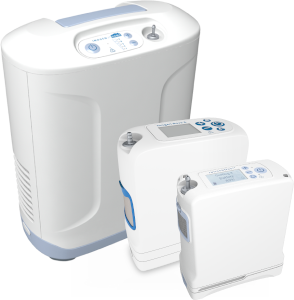Oxygen therapy is a common pulmonary fibrosis treatment, and one that can significantly improve the quality of life for patients living with low pulmonary fibrosis oxygen levels.[1] One of the hallmark symptoms of pulmonary fibrosis is breathlessness, which significantly impacts patients’ ability to maintain their daily activities.[2]
When used as a pulmonary fibrosis treatment, pulmonary fibrosis oxygen therapy can help improve breathlessness and the fatigue associated with it so that patients are better able to maintain regular activities. In addition, there are a variety of other treatments that can be used in conjunction with oxygen therapy for the greatest therapeutic benefits.[1]
So what is the best treatment for pulmonary fibrosis? Read on to explore pulmonary fibrosis causes and treatment.
What Causes Pulmonary Fibrosis?[3]
Pulmonary fibrosis (PF) is a kind of interstitial lung disease that causes scarring of the lung tissue. Unfortunately, in most cases there is no known cause of pulmonary fibrosis, though there are over 200 different types of the disease. When there is no known cause, it is called idiopathic pulmonary fibrosis (IPF), which is the most common type of PF. However, there are a few types of pulmonary fibrosis with known causes. Here are the types of pulmonary fibrosis with known causes.
- Pulmonary fibrosis caused by disease: Autoimmune diseases like rheumatoid arthritis, scleroderma or Sjogren’s syndrome can cause PF.
- Pulmonary fibrosis caused by certain viral infections or GERD: Breathing in tiny drops of acid as a result of GERD can cause scarring in the lungs, leading to PF.
- Familial pulmonary fibrosis: This form of PF is quite rare, and results with two or more members of a family have idiopathic PF. While some genes have been linked to PF, not enough is known to provide definitive answers.
- Pulmonary fibrosis resulting from exposure: Exposure to lung irritants like asbestos or silica dust, as well as exposure to certain animal and bird droppings, can cause PF. Additionally, radiation treatments, certain medications and cigarette smoking can lead to PF.
Pulmonary Fibrosis Treatment Guidelines[1]
There are a number of different options when it comes to pulmonary fibrosis treatment guidelines. Each pulmonary fibrosis treatment is designed to help slow the progression of your disease and to help ease your symptoms, so you can live as normal a life as possible. After you are first diagnosed, you will likely want to know, “What is the best treatment for pulmonary fibrosis?” Your health care team will work with you to determine your pulmonary fibrosis causes and treatment. The following options are commonly included in the pulmonary fibrosis treatment guidelines.
- Medication: Depending on the type of pulmonary fibrosis you have, there may be medications to slow progression of the disease and others that will help relieve your symptoms. Only your medical provider can determine if any medications may be beneficial for you. Drug therapy may include:
- Anti-fibrotic medications that have been shown in clinical trials to slow down the rate of fibrosis or scarring in the lungs. These drugs are approved for patients with mild, moderate and severe IPF.
- Drugs to reduce inflammation such as steroids or immuno-suppressants
- Medication to treat the dry, hacking cough that is a common symptom of PF
In addition, doctors may recommend anti-acid medications to reduce the amount of acid from the stomach that enters the lungs
- Pulmonary rehabilitation: Pulmonary rehab includes a number of different therapeutic approaches to help improve overall mental and physical health. These can include breathing techniques, counseling, nutritional and health education, physical exercise to improve exercise tolerance and support groups.
- Lung Transplant: In pulmonary fibrosis, once the lung tissue becomes scarred, the damage cannot be reversed. In certain cases where the lung scarring is significant, but the patient is otherwise in good health, a lung transplant may be suggested. However, since this is a major surgery and comes with significant risk, only a pulmonary specialist can help you decide if this is the right pulmonary fibrosis treatment for you.
What is the best treatment for pulmonary fibrosis for you? Do your research, know your options and talk to your doctor about what is best for you.
What Are the Benefits and Risks of Oxygen Therapy for Pulmonary Fibrosis?
There are a number of benefits to using oxygen therapy as a pulmonary fibrosis treatment. It may help reduce your shortness of breath and make it easier for you to stay active. You may need oxygen all day long, or only at night or when you exercise. Each PF patient’s oxygen needs are unique and depend on the severity of their disease and lifestyle. Your doctor will have you perform a simple walking test to see if you need supplemental oxygen. You will monitor your oxygen levels at home using handheld pulse oximeters (available over the counter in many pharmacies). You will aim to maintain your oxygen saturation level above 90 percent throughout the day and night. Getting started with oxygen can be challenging but most PF patients find that oxygen doesn’t limit their lives—it actually allows them to do more.
There is some minimal risk to using oxygen for your pulmonary fibrosis treatment, though the risks are small when you use oxygen as directed. Oxygen allows fire to burn more easily, so stay 5 feet away from any heat sources, open flames or sparks. Do not smoke while using oxygen, and avoid storing your oxygen device in direct sunlight.[4] Too much oxygen also poses a health risk, so follow your doctor’s instructions for using oxygen, and never make any adjustments without first discussing it with your doctor.
When used properly, pulmonary fibrosis oxygen therapy has many benefits. Talk to your doctor about whether oxygen therapy is the right pulmonary fibrosis treatment for you, and contact Inogen to find out more about how our portable oxygen concentrators may fit into your PF treatment plan.
References
- https://www.lung.org/lung-health-diseases/lung-disease-lookup/pulmonary-fibrosis/patients/how-is- pulmonary-fibrosis-treated
- https://www.lung.org/lung-health-diseases/lung-disease-lookup/pulmonary- fibrosis/introduction/symptoms
- https://www.lung.org/lung-health-and-diseases/lung-disease-lookup/pulmonary- fibrosis/introduction/types-causes-and-risk-factors.html
- https://www.lung.org/lung-health-diseases/lung-procedures-and-tests/oxygen-therapy/using-oxygen- safely







